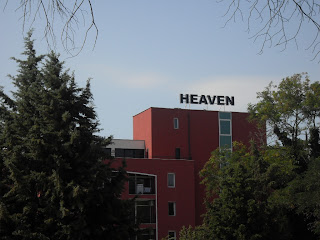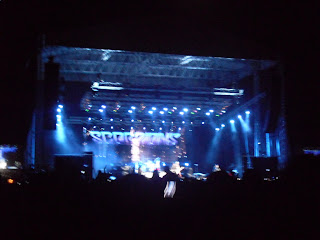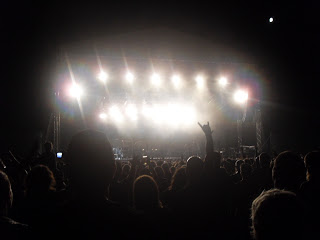The days leading up to the camp involved a lot of running around and coordinating different organizations to help out with the activities we had planned. At the same time, the camp was being changed from 5 days to 7 days to 4 days, back to 7 days, and then to 5 days again, before we finally settled on 4 days of activities and then a sort of free day. This system worked out pretty well, not only because the kids from Dren would be able to get back easier, but because it would allow us to plan fuller days of activities.

Day 1: Museum Day and the Scavenger Hunt – We got all the kids together for the first time outside of the orphanage and played some games like the human knot and duck-duck-goose. We then walked up to the museum where we got a talk from one of the archeologists in residence there, as well as a tour of all the exhibits (including one housed in a vault behind a foot thick metal door). After looking around a bit, we started the day’s main activity, the museum scavenger hunt, in which the kids were to look through the exhibits for certain things and the team with the highest amount of points wins. The kids got really into it, and we actually went over our planned allotted time. The museum actually asked to have copies of the scavenger hunt for future visitors, so I would say it was an all around success. While we were sitting around counting points at the end, everyone was kind of bummed that nobody found one of the clues on the list – a pony. Just as everyone was almost done counting, guess what pulls up… that’s right a pony and mother horse pulling a cart together. Everyone went crazy, and it was the perfect cap to a hugely successful activity. After that, the kids had a picnic in the park and we spent the rest of the day playing sports and doing arts and crafts and things with the other kids.

Day 2: Ruins and the dig site – We walked to the ruins of the citadel of Preslav just outside of town where there was a huge team of archaeologists digging for artifacts. The archaeology major in our group (the volunteer who coordinated the camp with me) was freaking out because of the haphazard digging methods at the site. One of the methods was to throw a whole bunch of dirt from the site into a pile and run a metal detector over it. Another involved chipping away fragile wall-looking areas with a pick axe. Good job, guys… Anyway, the kids were able to ask the archaeologists questions, and we even got the head professor to come out and talk to the kids about what was going on at the site. From there we walked up to another section of ruins where they actually let people climb up into a reconstructed area of the old fortress. The kids really got a kick out of that and played around for a bit. We then reached the last part of the ruins, the golden church of Tsar Simeon, where we rested for a bit and played some good old American football.

Day 3: The hike to Patleyna…. Sort of – We had planned to have everyone in the camp come hiking with us up to Patleyna (which I wrote about in a previous entry). However, several of the older children and the 2 supervisors refused to come with us because they thought it was too long. So we left without them. Apparently the activity the orphanage people thought up for them was to clean the building, so the people who went on the hike were pretty happy. The kids seemed to really enjoy the old 10th century monastery up there, and we even got to poke around at the newer monastery, where we found a bit of old Communist propaganda (“The party of Lenin is our vanguard!”). The kids that came with us also had a great time at the miniature zoo they have up there which featured doves and peacocks. I think some of the kids were actually kind of scared of the peacock since they hadn’t really seen anything like it before. Tired after a couple of hours walking round-trip, we finished out the day with some group games, baseball and volleyball. Baseball was especially interesting, as the kids were really getting into the home-run derby setup we started. After a couple hours of playing, the man who runs the stadium comes in shouting at us and telling us we have to leave. Confused, since we were being very good, and the kids were having a great time, we asked him why we had to leave. His answer was that we were making holes in the ground with the bats. Bewildered, we decided not to argue and left…

Day 4: Capture the flag and Time Capsule – We started off the day by going up to the stadium to play some relay games. We played a game featuring spoons and ping pong balls (which they weren’t that into) and did the dizzy-bat relay (which they were into, but we ended a bit prematurely as a lot of kids were falling all over the place). We then went to the park and introduced capture the flag, a game that the kids had never heard of before. They really enjoyed it, and the kids were actually filling their roles on the team quite well (i.e. prison guards acting like actual prison guards). It seemed that the game had reached a standstill, when one of the teams tried for a huge push and ended up getting a lot of their team captured, allowing the other to go in and take the flag pretty easily after about 10 minutes. I think this game was one of the most successful things we did and definitely one of the highlights. The kids from my orphanage are already asking when we’re going to play it again. During the afternoon, we made a time capsule, in which the kids wrote down their favorite memories from the camp and what they envision for themselves 20 years in the future. We then took pictures in front of the monument in the center of town, effectively putting a cap on the main portion of the camp.
Most of the volunteers left on Friday morning, but the supervisors took all the kids out to the fortress in Shumen to continue the archaeology theme. I saw the kids from the other place as they were leaving and may had made new friends and didn’t want to leave. So all in all, after all the hard work and stress, the camp was pretty successful, and we’re planning on doing something similar again next year. The supervisor from Dren actually invited our kids out there for next year, so we’ll see what we can get together. I know I learned a lot about how to run a successful camp, what works, and what fails miserably. I think that next time we’ll skew for a bit of a younger group as well. All in all, it was a great time, and while I’m glad it’s over, I’m also glad we were able to put together a successful camp (without many resources) that created new friendships for the kids and gave them some great experiences.
Until next time…

PS... Andrea took these pictures. My camera is once again out of commission... Thanks~














































